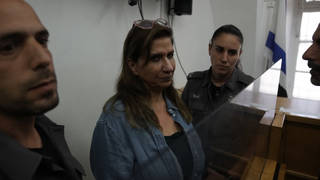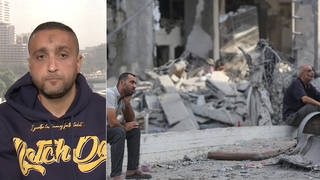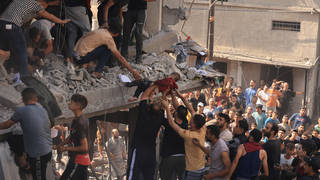
Related
Topics
Guests
- Marc Garlascosenior military analyst for Human Rights Watch. He is on the northern border of Gaza.
- Mads Gilberta Norwegian doctor who worked at Al Shifa hospital in Gaza during the Israeli assault.
Israel is coming under increasing criticism for its possible use of banned and experimental munitions. Human Rights Watch has accused Israel of illegally firing white phosphorous, which causes horrific burns if it comes in contact with the skin, over crowded refugee camps in Gaza. Medics and human rights groups are also reporting that they are seeing injuries distinctive of another controversial weapon, Dense Inert Metal Explosive, known as DIME, that was designed by the US Air Force in 2006. Those struck by the weapon who survive suffer severe mutilations and internal injuries. We go to the Gaza border to speak with Marc Garlasco of Human Rights Watch and to Norway to speak with Dr. Mads Gilbert, who just returned from the Shifa Hospital in Gaza City. He says Gaza is “truly a scene from Dante’s Inferno.” [includes rush transcript]
Transcript
AMY GOODMAN: As the assault on Gaza enters its nineteenth day, Israel is coming under increasing criticism for its possible use of banned and experimental munitions. Human Rights Watch has accused Israel of illegally firing white phosphorous over crowded refugee camps in Gaza. White phosphorous shells cause horrific burns if they come in contact with the skin. Under international law, phosphorus is allowed as a smokescreen to cover troop movements and protect soldiers or to be used for illumination, but it’s considered illegal if used against people.
In addition to white phosphorous, medics and human rights groups are reporting they are seeing injuries distinctive of another controversial weapon. The munition, called DIME, for dense inert metal explosive, was designed to create a powerful blast over a small area. It was developed by the US Air Force in 2006. Those struck by the weapon who survive suffer severe mutilations and internal injuries. The weapon causes the tissue to be torn from the flesh. Unlike traditional munitions, there is said to be no shrapnel. Instead, particles of metals can be found in the bodies of those affected. Those residues have been found on victims in Gaza.
Israel has denied it’s using either white phosphorous or DIME weapons.
Joining us now on the phone from Norway is one of the doctors who first accused Israel of using the DIME explosives: Dr. Mads Gilbert, an expert in emergency medicine. He and his colleague Erik Fosse have just returned from the Shifa Hospital in Gaza City, where they were volunteering through the aid organization NORWAC. Shifa Hospital is the largest hospital in Gaza.
We’re also joined by Marc Garlasco on the northern border of Gaza. He is a senior military analyst for Human Rights Watch, investigating Israel’s use of white phosphorus.
Marc Garlasco, on the border in Gaza, I want to start with you. You worked for the Pentagon. You know your weapons well. What are you seeing?
MARC GARLASCO: Well, when you stand on the border of Gaza, you watch every day as white phosphorus rounds are lobbed over with 155-millimeter artillery. We watch as Cobra and Apache gunships fly in and do strafing runs, run after run after run. You can see Heron drones overhead dropping bombs, additionally F-16s, and F-16s come in occasionally to drop aerial ordnance. It’s much quieter now than it was days ago. But still, it’s a continuous barrage, particularly lately on the refugee camps and in closer to Gaza City, which is where we’re looking at.
AMY GOODMAN: Now, you’re making a very serious accusation: the use of white phosphorus as a weapon, as opposed to illumination or a smokescreen. What evidence do you have of this?
MARC GARLASCO: Well, we have not stated that Israel is using it as a weapon. We’ve clearly stated that we’re standing on the border, observing day after day the Israeli Defense Forces firing white phosphorus into the refugee camps and Gaza City. Now, we are not there on the ground to observe any further how it’s being used. I’m about like, say, a mile away. And so, from that distance, you can see very precisely that it’s going in. Whether it’s being used as — you know, right now, we can tell it’s being used as an obscurant, but we have no further information to state whether or not they’re using it as a weapon, and we have not stated that.
AMY GOODMAN: In terms of what happens when it comes in contact with the skin?
MARC GARLASCO: Well, clearly, I would say we need to talk to Dr. Gilbert about the specifics, but from our understanding, you’re looking at third-degree burns that continue to burn until the fuel is exhausted. Fuel from white phosphorus burns for approximately five to ten minutes, as it’s creating the smoke, and if it goes onto the skin, it has to be removed. Otherwise, it will continue to burn.
And that’s clearly one of our gravest concerns. Our concern is that Israel is not taking all feasible precautions to spare the civilians from harm and that we’re going to see civilian casualties from white phosphorus use. You know, it cannot determine who is a target, who is a military target, and who’s a civilian, because it covers an area up to 250 meters in diameter, quite large. And these are densely populated refugee camps we’re talking about.
AMY GOODMAN: Let me go to Dr. Mads Gilbert, who has just returned from Gaza, the Shifa Hospital. He’s back in Norway right now. What did you see, in terms of the casualties, both when it comes to white phosphorus and also with this new weapon that you have been talking about called DIME?
DR. MADS GILBERT: I will answer that, but I think it’s important to understand that the most devastating weapon they are currently using is actually the siege of Gaza, which has been on for eighteen months, which means a lot of starvation, lack of food, water, power supplies, medicines, napkins, anything that people need to live. So it’s one-and-a-half million people who basically is now without their absolutely necessary means for living their lives, and that is, of course, illegal.
When it comes to the weaponry, we did not see clear evidence in patients that we received that they had been hit by white phosphorous, but we were told by the doctors and colleagues in Shifa that during the first days of the invasion, the ground invasion, they had seen this affecting as a side effect of the smokescreen use of the white phosphorus. And that was inhalation injuries, meaning that people have been breathing the phosphorus damp into their lungs, and burns. Also, by the end of our mission, when we left, there were fierce attacks in the south, and again the doctors in the European Hospital in South Gaza reported the same thing: burns and inhalation injuries. So it seems like my expert on the [inaudible] is right, that using such chemical means in so densely populated areas, as Gaza is, you will evidently have to affect also the civilians.
When it comes to the DIME weapons, we have seen a substantial number of amputations, where the amputees do not have shrapnel injuries. On the contrary, they have torn apart their legs, often one or two or even three limbs, their arm also. Some of them are beyond salvage, because the amputations are so high and so fierce that it also affects the lower part of the body. Some are survivable. But typical for these amputations is that there is no sign of metal fragments or shrapnel. It is only this very brutal amputations caused by some extreme power and small rice grain, rice, corn, pieces of some kind of substance, not metal, but — you know, the DIME weapon is a mixture of metals, nickel and cobalt, in a composite cast, not in a metal cast. And that’s explaining why you don’t see shrapnel.
The additional effect in animal studies on the DIME weapon is that the residuals in the muscle in mice will cause a very severe form of muscle cancer called rhabdomyosarcoma, which easily spreads to the lungs. This remains to be shown.
I underline we don’t have proof, but we have strong evidence that these amputations we’ve been seeing in Gaza for the last eleven days must come from some type of weapon that we don’t know of.
AMY GOODMAN: Can you explain more fully these kinds of amputations, Dr. Gilbert?
DR. MADS GILBERT: You know, often, if you have a grenade amputation or an amputation from any kind of metal fragment, it will be more like you had a hatch or an ax or a huge knife that cut through your bone and the muscle. What we see in these suspected DIME amputations is that the whole limb is crushed in a way that must suggest some sort of immense power that has hit the lower part of the body. And we know that these small bombs, which the DIME bombs are, explodes in a way so that it will mainly affect the lower limbs. The limbs are — you will have multiple very severe fractures. The muscles are sort of split from the bones, hanging loose. And you also have quite severe burns where this energy wave has hit.
If you look at pictures from sites where these patients have come, you don’t see fragments in the walls in the house around, maybe fifteen, twenty meters apart from the explosions. And you see only some stripes of power in the sand on the ground, and these actually are the examples that the power dissipates very quickly, maybe within five or ten meters of the explosion, so that you will not have this kind of collateral damage, as it’s called. But in Gaza, again, so densely populated, that these DIME weapons will have a devastating effect. Also, they are, by some, classified as nuclear weapons.
AMY GOODMAN: Nuclear weapons?
DR. MADS GILBERT: Well, the EU Commission on nuclear matters have stated clearly that these weapons, since they are based on a fission process, you need to investigate more the residuals, if that is radioactive. That has not been done. It was not done in Lebanon in 2006, when these weapons were first described. And it has not been done in Gaza in 2006 and now this — I saw the similar injuries in Gaza around Easter 2006 — excuse me, 2008, that is, during the incursions in Jabalya, exactly the same types. And I believe there are some sixty-six cases described at Shifa Hospital before this war.
AMY GOODMAN: Marc Garlasco, you worked for the Pentagon. These DIME weapons, dense inert metal explosive, were developed by the US Air Force. Do you know about them?
MARC GARLASCO: Well, only what we’ve read about. I mean, I left the Pentagon long before these were developed. These weapons were developed in 2006, so they’re extraordinarily new. I’ve been on a number of battlefields, and one of the problems is that from what we’ve read in literature, when the DIME explodes, you’re looking at no residual pieces. And so, it becomes very problematic to go in on an investigation looking for forensic evidence, when it, in effect, eats itself up in the explosion.
And you have to remember, these weapons, interestingly, were developed to save civilians, to minimize civilian casualties, so that if the weapon explodes and kills anyone within the blast radius of, let’s say, ten meters to twenty meters, it immediately drops off in power, and so no one dies outside that area, whereas the standard bomb today, when it explodes, you have many hundreds of meters of blast and fragmentation damage. So if it is, in fact, being used, which we have no proof that it is, and civilians are dying, it’s most interesting, sadly, that it was originally developed to, in fact, spare civilians from harm.
AMY GOODMAN: Marc Garlasco of Human Rights Watch, if DIME isn’t yet licensed, technically still under development, would the US have to give permission to Israel to use it?
MARC GARLASCO: Well, the US has very strict requirements, as far as when a weapon finally gets through its process of acceptance, where it gets both a legal and a medical review, as well as effectiveness review. It remains to be seen how Israel has acquired the technology, whether they purchased weapons from the United States under some agreement, or if they’ve in fact licensed or developed their own type of munition.
To be honest with you, we have to remember one thing. At this point, there are a lot of rumors, and nothing has yet been substantiated. Only until we’re able to get on the ground and do the work that Israel is stopping us from doing will we really know what’s going on in Gaza.
AMY GOODMAN: Explain that further. We’re talking to you on the border. Why aren’t you in Gaza right now, Mark Garlasco?
MARC GARLASCO: Well, Israel refuses to allow the international media and human rights monitors entry into Gaza. And I have worked in Gaza numerous times, and this is the first time that we’ve been denied access. We do have one individual, who is our Palestinian worker, who’s in Gaza right now. His father was killed by the Israelis earlier this week, and his house was destroyed yesterday in an air strike. And his wife is giving birth today. So he’s got a lot going on in his life. Our thoughts are with him and all the other Palestinian civilians there, with the Israelis who are coming under fire from the Hamas rockets. And hopefully, we will see this end very soon, and we will be able to get in on the ground and do our investigations.
AMY GOODMAN: And finally, Dr. Mads Gilbert, you’ve just come back from Gaza. You worked in the hospital. We were talking about white phosphorus. We were talking about DIME. But the condition in the hospitals right now?
DR. MADS GILBERT: Well, I have to underline what my friend on the border is saying. There’s been a palpable absence of international presence. In fact, Dr. Fosse and myself were the only two Westerners in Gaza for those first ten days we stayed there. And it’s absolutely incomprehensible that we, in 2009, we do not have the press on such war ground as Gaza is. And I think also it’s urgent to have international agencies come in and exactly do the examination on the ground to find out what kind of weapons are used.
The condition in Shifa Hospital and in the other hospitals in Gaza is horrifying. I’ve been to Gaza for the last ten years, in and out, teaching and training people in the medical field. I’ve never seen anything like this. I mean, all windows in the Shifa Hospital are out, due to the bombing of the mosque across the street. They have very unstable electricity. They lack supplies, disposables, surgical equipment, trolleys, beds even. They have a fantastic staff, who are working heroically to save their patients, but we have been doing surgery with, almost regularly, two patients in each OR, on the wall, on the floor, in the corridors. The lifts are barely working. The ICU had to triple its capacity with makeshift ICUs.
It is really, truly a scene from Dante’s Inferno. It is these loads of patients coming in. We had 120, 130 patients coming a day, children, women. And I would say approximately 90 percent — I repeat, 90 percent — of the killed and injured that we have seen are civilians. Up ’til yesterday, 971 people have been killed; of them, one of three is a child below eighteen. 4,500 injuries, as of yesterday at 4:00; among them, every second is a woman or a child. So this is really targeting civilian Palestinian population. And we had a large number of pediatric cases with head injuries, with complicated fractures —
AMY GOODMAN: Dr. Mads Gilbert, we’re going to have to leave it there. I thank you for being with us, Norwegian doctor, just back from Gaza. Marc Garlasco, still on the Gaza border — Israel won’t let him into Gaza — with Human Rights Watch. Human Rights Watch has called for Israel to stop using white phosphorus in military operations.











Media Options